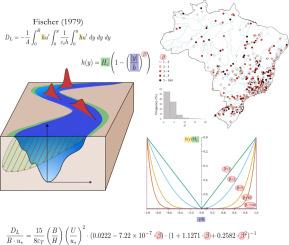基于溪流和河流水力几何的纵向弥散系数
IF 4.2
2区 环境科学与生态学
Q1 WATER RESOURCES
引用次数: 0
摘要
纵向弥散系数是决定河流中污染物命运和运移的关键。然而,其经验估计通常受到缺乏数据和流量和通道几何关系复杂性的阻碍。在这项研究中,我们建立了一个纵向色散系数的解析方程,该方程考虑了通过水力几何关系获得的通道截面特征。解析方程通过结合Deng et al.(2001)的简化和Fischer的三重积分来求解。我们使用基于巴西河流水力几何的形状参数数据集来测试新方程。所提出的方程强调了开放形状特定位置参数的包含增强了纵向色散系数的估计。本文章由计算机程序翻译,如有差异,请以英文原文为准。

Longitudinal dispersion coefficient based on hydraulic geometry of streams and rivers
The longitudinal dispersion coefficient is key to determining the fate and transport of pollutants in rivers. However, its empirical estimation is usually hindered by a lack of data and the complexity of discharge and channel geometry relations. In this study, we develop an analytical equation of the longitudinal dispersion coefficient that takes into account channel cross-section characteristics obtained through hydraulic geometry relations. The analytical equation is solved by combining the simplification made by Deng et al..(2001) with Fischer’s triple integral. We test the new equation using a dataset of the shape parameter based on the hydraulic geometry of Brazilian rivers. The proposed equation highlights that the inclusion of an open shape site-specific parameter enhances the estimation of the longitudinal dispersion coefficient.
求助全文
通过发布文献求助,成功后即可免费获取论文全文。
去求助
来源期刊

Advances in Water Resources
环境科学-水资源
CiteScore
9.40
自引率
6.40%
发文量
171
审稿时长
36 days
期刊介绍:
Advances in Water Resources provides a forum for the presentation of fundamental scientific advances in the understanding of water resources systems. The scope of Advances in Water Resources includes any combination of theoretical, computational, and experimental approaches used to advance fundamental understanding of surface or subsurface water resources systems or the interaction of these systems with the atmosphere, geosphere, biosphere, and human societies. Manuscripts involving case studies that do not attempt to reach broader conclusions, research on engineering design, applied hydraulics, or water quality and treatment, as well as applications of existing knowledge that do not advance fundamental understanding of hydrological processes, are not appropriate for Advances in Water Resources.
Examples of appropriate topical areas that will be considered include the following:
• Surface and subsurface hydrology
• Hydrometeorology
• Environmental fluid dynamics
• Ecohydrology and ecohydrodynamics
• Multiphase transport phenomena in porous media
• Fluid flow and species transport and reaction processes
 求助内容:
求助内容: 应助结果提醒方式:
应助结果提醒方式:


